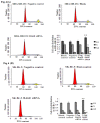Specific siRNA targeting receptor for advanced glycation end products (RAGE) decreases proliferation in human breast cancer cell lines
- PMID: 23579957
- PMCID: PMC3645726
- DOI: 10.3390/ijms14047959
Specific siRNA targeting receptor for advanced glycation end products (RAGE) decreases proliferation in human breast cancer cell lines
Abstract
Receptor for Advanced Glycation End Products (RAGE) is an oncogenic trans-membranous receptor overexpressed in various human cancers. However, the role of RAGE in breast cancer development and proliferation is still unclear. In this study, we demonstrated that RAGE expression levels are correlated to the degree of severity of breast cancer. Furthermore, there is a decrease in the proliferation of all sub-types of breast cancer, MCF-7, SK-Br-3 and MDA-MB-231, as a result of the effect of RAGE siRNA. RAGE siRNA arrested cells in the G1 phase and inhibited DNA synthesis (p < 0.05). Moreover, qRT-PCR and Western Blot results demonstrated that RAGE siRNA decreases the expression of transcriptional factor NF-κB p65 as well as the expression of cell proliferation markers PCNA and cyclinD1. RAGE and RAGE ligands can thus be considered as possible targets for breast cancer management and therapy.
Figures













References
-
- Poellinger A. Near-infrared imaging of breast cancer using optical contrast agents. J. Biophotonics. 2012;5:815–826. - PubMed
-
- Beckmann M.W., Niederacher D., Schnurch H.G., Gusterson B.A., Bender H.G. Multistep carcinogenesis of breast cancer and tumor heterogeneity. J. Mol. Med. 1997;75:429–439. - PubMed
-
- Lerebours F., Lidereau R. Molecular alterations in sporadic breast cancer. Crit. Rev. Oncol. Hematol. 2002;44:121–141. - PubMed
-
- Balmain A., Gray J., Ponder B. The genetics and genomics of cancer. Nat. Genet. 2003;33:238– 244. - PubMed
Publication types
MeSH terms
Substances
LinkOut - more resources
Full Text Sources
Other Literature Sources
Medical
Research Materials
Miscellaneous

